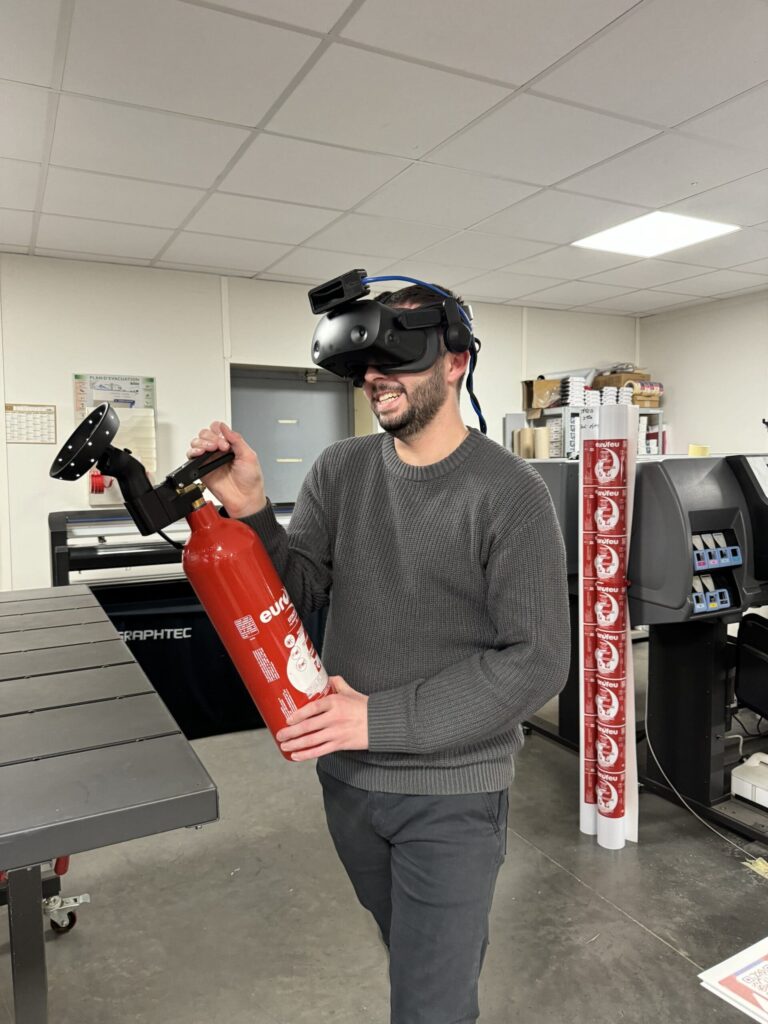Can you use an extinguisher without training?
Using an extinguisher may seem straightforward, but does it require training? In the professional world, regulations are clear: training in the use of fire extinguishers is compulsory. This is part of an approach to fire risk prevention, and concerns all companies, whatever their size. This training, which is often renewed with refresher courses, is designed to ensure employee safety in the event of fire.
Understanding the role of an extinguisher in the event of fire
The extinguisher plays a crucial role in a fire, enabling rapid action to limit the damage. It is designed to extinguish an incipient fire before it spreads. Portable extinguishers are indispensable for immediate intervention.
There are different types of extinguisher for different classes of fire. For example:
- Water extinguishers: effective on Class A fires involving solid materials such as wood.
- CO2 extinguishers: ideal for electrical fires, as they extinguish flames without leaving residues.
- Powder extinguishers: versatile, suitable for Class A, B and C fires.
Correct use requires knowledge of the type of fire and the appropriate extinguisher. Regular drills and familiarity with safety instructions are essential to ensure a successful response.
Handling a fire extinguisher: can anyone do it?
Using a fire extinguisher requires a certain dexterity that is not innate. Although the extinguisher is an accessible tool, its effective handling requires training. Training is crucial to understanding how to choose the right extinguisher for each class of fire:
- Class A fire (solid materials): water spray extinguisher.
- Class B fire (flammable liquids): foam or powder extinguisher.
- Class C fire (gas): powder extinguisher.
Recognizing the type of fire is essential to avoid costly mistakes. For example, using a water extinguisher on a flammable liquid fire could make the situation worse. Training courses often include practical exercises on simulated fires, enabling participants to acquire the necessary reflexes in the event of an emergency. Thanks to these sessions, everyone can become a safety player in their own working environment.
Regulations governing the use of fire extinguishers
Article R4227-39: what exactly does it say?
Article R4227-39 of the French Labor Code imposes strict fire safety obligations on companies. According to this text, every employer must organize fire-fighting drills at least every six months. These drills include the use of first-aid equipment such as fire extinguishers.
The aim is to ensure that all workers are able to recognize the general alarm signal and use safety equipment.
Training for these exercises is not limited to theory. It also includes practical sessions that enable employees to develop the reflexes needed to deal with an emergency situation.
A safety register must document these exercises, guaranteeing traceability and rigorous monitoring of the training carried out.
All in all, this contributes to the effective protection of all staff and the maintenance of a safe working environment.
The company training obligation: why is it necessary?
In-house training is essential for a number of reasons. Firstly, it ensures that every employee has the necessary skills to handle a fire extinguisher effectively when needed. By reducing the risk of a fire spreading, it protects not only individuals, but also the company's infrastructure.
Proper training includes key elements such as :
- Recognizing different types of fire and the appropriate extinguisher.
- Regular practice to develop fast reflexes.
- Understanding safe evacuation instructions.
A concrete example shows that in the event of a fire, a trained employee can intervene immediately, avoiding major damage and significant economic losses. This preparedness reduces potential damage and ensures a rapid, coordinated response to an emergency situation, boosting confidence and safety within the company.
Recycling: how often and for whom?
When it comes to recycling fire extinguishers, the frequency depends mainly on the regulations in force and the needs of the company. Refresher training is generally recommended every three years for employers who have already trained their staff.
This process ensures that skills remain up to date and that employees are ready to intervene in the event of a fire. The main beneficiaries of this retraining include companies and public establishments where fire risks are present.
What's more, some companies choose to renew their knowledge every year, especially when operating in high-risk environments. A typical example is the chemical industry, where handling flammable materials requires extra vigilance.
Recycling enables us to maintain a high level of safety and meet legal requirements, guaranteeing a safe working environment.
The risks of untrained use
Can I use an extinguisher without training?
Using an extinguisher without training can be risky. Without prior knowledge, you could injure yourself or make a fire worse. For example, choosing the wrong extinguisher for a specific type of fire can have disastrous consequences.
It's also possible not to know how to use it effectively, which can delay extinguishing the fire. Here are some of the potential risks of using an extinguisher without training:
- Inhalation of toxic fumes: without the right techniques, you risk exposing yourself to fumes.
- Injuries: incorrect handling may cause burns or falls.
- Fire spread: choosing the wrong extinguisher can make matters worse.
To avoid these dangers, it's a good idea to undergo specialized training so that you can react appropriately in the event of an outbreak of fire.
The consequences of misusing an extinguisher
Incorrect use of an extinguisher can have a number of harmful consequences. Not only can it make a fire worse, it can also cause injury to the user. For example, directing the jet upwards instead of at the base of the flames can allow the fire to spread.
Common errors include:
- Choosing the wrong type of extinguisher for the fire, which can intensify the fire
- Use the extinguisher without checking that it is in good working order, which could render it ineffective.
- Failing to position yourself correctly in relation to the fire, thus increasing the risk of smoke inhalation
Every mistake can have serious repercussions. Inappropriate use of a fire extinguisher can also cause major property damage. An untrained employee could panic, leading to hasty and potentially dangerous actions.
Employer's fire safety rights and responsibilities
In the event of fire, the employer has a clear legal responsibility. He must implement a series of measures to guarantee the safety of all occupants of the establishment. This includes providing a sufficient number of fire extinguishers, and maintaining them regularly.
The employer must also organize regular training sessions to ensure that all employees know how to use these extinguishers correctly. These training sessions enable workers to react effectively in the event of a fire.
Obligations also include proper signage of safety equipment. Fire extinguishers and emergency exits must be clearly identified for easy access in an emergency.
In addition, the employer must carry out periodic evacuation drills. These drills are designed to test the effectiveness of safety systems and ensure a rapid, coordinated response.
By complying with these obligations, employers contribute to a safe working environment.
Focus on fire extinguisher training
Training content and objectives
Fire extinguisher training is designed to equip participants with the essential skills to act effectively in the event of a fire. It includes a theoretical component in which trainees learn about the different types of extinguishers, their characteristics and their use according to the type of fire. This approach is complemented by practical exercises, enabling participants to handle extinguishers on real or simulated fires, boosting their confidence and responsiveness.
The main objectives include :
- Identify fire classes and choose the right extinguisher
- Acquire the gestures and safety reflexes needed to intervene rapidly
- Awareness of evacuation and safety instructions
These skills not only help limit material damage, but also ensure the safety of those present when a fire breaks out.
Who needs this training?
Fire extinguisher training is aimed primarily at all employees, whatever their sector of activity. This program is essential to ensure that every employee can react quickly and effectively to an outbreak of fire. It is particularly recommended for those working in high-risk environments, such as industries handling flammable materials.
Companies with more than 50 employees must ensure that all staff receive training, while in establishments open to the public, this obligation extends to all employees. Even new recruits must receive this training on arrival.
By offering this training, companies not only ensure the safety of their employees, but also comply with fire safety legislation.
Is fire training compulsory for everyone, and at what pace?
Fire training is compulsory for all employees, in accordance with the French Labor Code. Evacuation and fire extinguisher drills must be carried out regularly to ensure the safety of all personnel.
In general, employees are required to undergo this training at least every six months. This helps maintain a high level of competence in the face of fire hazards.
For companies handling flammable materials or with more than 50 employees, specific safety instructions apply. Training often includes a theoretical part, followed by practical exercises.
It's crucial to ensure that all new employees receive this training as soon as they arrive. This is an integral part of fire prevention measures, and ensures their ability to react effectively when needed.
Alternatives to traditional training: digital technology for fire safety
Digital tools are revolutionizing fire safety training by offering modern, tailored solutions. Here are just a few advantages:
- Accessibility: Online platforms enable employees to train at their own pace, reducing logistical constraints.
- Interactivity: Virtual simulations, such as the BullsEye system, offer immersive, realistic training without the risks associated with real fires.
- Personalized follow-up: applications can monitor participants' progress and adapt modules to their specific needs.
One concrete example is the use of 3D simulations to learn how to handle different types of extinguisher in a variety of scenarios, boosting user confidence and competence. These innovations are transforming the way companies approach fire safety training, making learning more effective and engaging.
Conclusion: the importance of informed use of extinguishers
Training employees in the use of fire extinguishers is essential to ensure a rapid and effective response to a fire. This know-how helps prevent material damage and protect human lives.
The benefits of such training include :
- Reduced stress during a fire thanks to safe, controlled actions.
- Knowledge of the different types of extinguishers and their proper use.
- Ability to quickly assess the situation and decide whether to intervene or evacuate.
A concrete example: a trained employee will be able to choose the right extinguisher for an electrical fire, thus avoiding potentially dangerous mistakes.
Finally, this training ensures compliance with current safety standards, reinforcing confidence within the team. In an emergency, every minute counts, and being well prepared can make all the difference.



